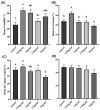Antioxidant Effects of Myo-Inositol Improve the Function and Fertility of Cryopreserved Boar Semen
- PMID: 37759976
- PMCID: PMC10525680
- DOI: 10.3390/antiox12091673
Antioxidant Effects of Myo-Inositol Improve the Function and Fertility of Cryopreserved Boar Semen
Abstract
During cryopreservation, sperm undergoes structural and molecular changes such as ice crystal formation, DNA fragmentation, and reactive oxygen species (ROS) production, leading to decreased sperm quality after thawing. Antioxidants play a crucial role in preventing these damages, both in vivo and in vitro. One potent antioxidant is myo-inositol, known for its protective effects on sperm against ROS. This study aimed to investigate the protective effect of myo-inositol on cryopreserved boar semen. The semen was diluted, cooled, and cryopreserved using a BF5 extender. It was then divided into five groups: control and different concentrations of myo-inositol (0.5, 1, 1.5, and 2 mg/mL). The post-thaw evaluation included assessments of motility, viability, acrosome integrity, mitochondrial membrane potential (MMP), caspase activity, gene expression, ROS levels, apoptosis, and IVF with treated semen. Results showed that myo-inositol at 0.5 mg/mL improved motility, acrosome integrity, and fertilization ability. It also reduced the expression of pro-apoptotic genes and increased SMCP expression. Lower concentrations also demonstrated improved viability and reduced apoptosis and ROS levels. In conclusion, myo-inositol treatment during cryopreservation improved sperm quality, reduced apoptosis and ROS levels, and enhanced fertility rates in boar semen.
Keywords: ROS; apoptosis; boar semen; cryopreservation; in vitro fertilization; myo-inositol.
Conflict of interest statement
The authors declare no conflict of interest.
Figures





Similar articles
-
Myo-inositol improves the viability of boar sperm during liquid storage.Front Vet Sci. 2023 Jul 26;10:1150984. doi: 10.3389/fvets.2023.1150984. eCollection 2023. Front Vet Sci. 2023. PMID: 37565079 Free PMC article.
-
Synergistic effects of myo-inositol and melatonin on cryopreservation of goat spermatozoa.Reprod Domest Anim. 2022 Aug;57(8):876-885. doi: 10.1111/rda.14131. Epub 2022 May 11. Reprod Domest Anim. 2022. PMID: 35467053
-
Effect of type and concentration of antioxidant on sperm motility, viability, and DNA integrity of climbing perch Anabas testudineus Bloch, 1792 (Pisces: Anabantidae) post-cryopreservation.Cryobiology. 2024 Mar;114:104851. doi: 10.1016/j.cryobiol.2024.104851. Epub 2024 Jan 17. Cryobiology. 2024. PMID: 38237749
-
Fertility of boar semen cryopreserved in extender supplemented with butylated hydroxytoluene.Theriogenology. 2015 Feb;83(3):307-13. doi: 10.1016/j.theriogenology.2014.07.045. Epub 2014 Oct 30. Theriogenology. 2015. PMID: 25468554 Review.
-
The effect of Myo-inositol on improving sperm quality and IVF outcomes: A systematic review and meta-analysis.Food Sci Nutr. 2024 Sep 12;12(11):8515-8524. doi: 10.1002/fsn3.4427. eCollection 2024 Nov. Food Sci Nutr. 2024. PMID: 39619962 Free PMC article. Review.
Cited by
-
Diacerein and myo-inositol alleviate letrozole-induced PCOS via modulation of HMGB1, SIRT1, and NF-kB: A comparative study.Naunyn Schmiedebergs Arch Pharmacol. 2025 Apr;398(4):4179-4197. doi: 10.1007/s00210-024-03497-7. Epub 2024 Oct 21. Naunyn Schmiedebergs Arch Pharmacol. 2025. PMID: 39432066 Free PMC article.
-
Myoinositol improves sperm parameters in diabetic rats by reducing oxidative stress and regulating apoptosis-related genes.J Mol Histol. 2025 May 21;56(3):165. doi: 10.1007/s10735-025-10451-1. J Mol Histol. 2025. PMID: 40397159
-
Untargeted metabolomics reveals changes in boar sperm and seminal plasma metabolites associated with sexual maturity.J Anim Sci Biotechnol. 2025 Sep 3;16(1):123. doi: 10.1186/s40104-025-01258-x. J Anim Sci Biotechnol. 2025. PMID: 40898314 Free PMC article.
-
Positive In Vitro Effect of ROCK Pathway Inhibitor Y-27632 on Qualitative Characteristics of Goat Sperm Stored at Low Temperatures.Animals (Basel). 2024 May 12;14(10):1441. doi: 10.3390/ani14101441. Animals (Basel). 2024. PMID: 38791659 Free PMC article.
-
The Clinical Use of Myo-Inositol in IVF-ET: A Position Statement from the Experts Group on Inositol in Basic and Clinical Research and on PCOS (EGOI-PCOS), the Polish Society of Andrology, and the International Scientific Association for the Support and Development of Medical Technologies.J Clin Med. 2025 Jan 16;14(2):558. doi: 10.3390/jcm14020558. J Clin Med. 2025. PMID: 39860564 Free PMC article. Review.
References
-
- Kinkar D., Sarkar D., Debbarma A., Rahman M., Swain S., Karunakaran M. Review on recent advancement in semen additives for improving cryopreservation of bull semen. J. Entomol. 2020;8:1493–1505.
-
- Oldenhof H., Wolkers W.F., Sieme H. Cryopreservation of Semen from Domestic Livestock: Bovine, Equine, and Porcine Sperm. In: Wolkers W.F., Oldenhof H., editors. Cryopreservation and Freeze-Drying Protocols. Springer; New York, NY, USA: 2021. pp. 365–377. - PubMed
-
- Dutta S., Henkel R., Sengupta P., Agarwal A. Physiological Role of ROS in Sperm Function. In: Parekattil S.J., Esteves S.C., Agarwal A., editors. Male Infertility: Contemporary Clinical Approaches, Andrology, ART and Antioxidants. Springer International Publishing; Cham, Switzerland: 2020. pp. 337–345.
Grants and funding
LinkOut - more resources
Full Text Sources

